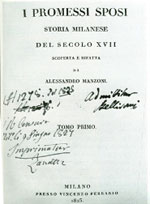|
 |
Home Page >
Biographical pathway > 1821-1827 > The novel's success
 The novel's success The novel's success
 In June 1827, Manzoni informed Fauriel that the Promessi Sposi had now been published. Three attractive volumes, bound in thick “hand-made paper” in Havana Gold, and with the title printed on the front (“as is the custom nowadays”). The novel met with immediate success, and by mid-August the two thousand copies of the first print had sold out. The novel’s reputation far exceeded the distribution capacity, especially outside Lombardy, as Manzoni was able to see for himself on his journey to Tuscany. It met with great success both among readers, who were captivated by this “popular novel”, and among critics, in spite of the reservations of Italy’s traditionalist literary circles towards such a new kind of work. All the intensive study and research on the history and places that were so much part of the novel’s subject-matter had set up keen expectations and curiosity in the literary world, to the extent that some expected a work of historiography rather than a novel about love. For this reason the discussion in the papers and journals (among the most important was Florence’s Antologia) focused on the relationship between history and invention. Exponents of classicism and Romanticism, literary figures and politicians (such as Mazzini), Italian and foreign intellectuals (such as Goethe) all participated in the lively debate that ensued. The novel was translated in several countries, with publishers and translators engaged in a race for the translation. In 1827, the Promessi Sposi had already been translated into German, though several other German versions followed, with numerous reprints. In 1828, it was translated into French, English and Danish. A Swedish translation appeared in 1832, and in 1845 work started on American translations (although Edgar Allan Poe had already admired and reviewed the novel earlier than this). In the short space of a few years, the novel was read in the main languages of Europe, in editions that very of high typographical quality but often unfaithful to the original on account of the difficulties inherent in its language and stylistic finesse. In June 1827, Manzoni informed Fauriel that the Promessi Sposi had now been published. Three attractive volumes, bound in thick “hand-made paper” in Havana Gold, and with the title printed on the front (“as is the custom nowadays”). The novel met with immediate success, and by mid-August the two thousand copies of the first print had sold out. The novel’s reputation far exceeded the distribution capacity, especially outside Lombardy, as Manzoni was able to see for himself on his journey to Tuscany. It met with great success both among readers, who were captivated by this “popular novel”, and among critics, in spite of the reservations of Italy’s traditionalist literary circles towards such a new kind of work. All the intensive study and research on the history and places that were so much part of the novel’s subject-matter had set up keen expectations and curiosity in the literary world, to the extent that some expected a work of historiography rather than a novel about love. For this reason the discussion in the papers and journals (among the most important was Florence’s Antologia) focused on the relationship between history and invention. Exponents of classicism and Romanticism, literary figures and politicians (such as Mazzini), Italian and foreign intellectuals (such as Goethe) all participated in the lively debate that ensued. The novel was translated in several countries, with publishers and translators engaged in a race for the translation. In 1827, the Promessi Sposi had already been translated into German, though several other German versions followed, with numerous reprints. In 1828, it was translated into French, English and Danish. A Swedish translation appeared in 1832, and in 1845 work started on American translations (although Edgar Allan Poe had already admired and reviewed the novel earlier than this). In the short space of a few years, the novel was read in the main languages of Europe, in editions that very of high typographical quality but often unfaithful to the original on account of the difficulties inherent in its language and stylistic finesse.
 
|
|
 |
 |
 |
 |
 |
 |
    |
